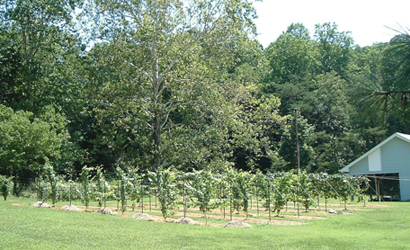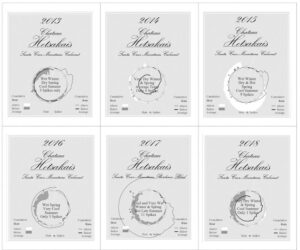
After retirement from the military I spent my GI Bill learning to make pottery. For ten years I breathed, ate and slept pottery (timrobertspottery.com). With total immersion, even in something as pleasant as making pots, I began to feel a need for a diversion. During all our travels my wife and I always sought out the wineries and sampled their wares. I had tried making hard apple cider several times with mediocre results, however I decided winemaking was going to be my new hobby.
Since we had some open space on our acre of property I decided to grow my own grapes and other fruit. Following recommendations on which type of grape to grow in our area, I planted four Concord and four Niagara vines — without having tasted wine made from either. I also planted two pears, a plum, a nectarine and three apple trees plus raspberries, blueberries and elderberries.
Before I started winemaking, I read many books about winemaking from the library and frequented WinePress.us for some winemaking guidance. I bought a couple of wine kits and also made several wines from frozen and canned concentrates, which is how I decided that Concord wine wasn’t for me even before my vines had produced any grapes. My taste is more for dry reds, however, there are occasions that a dry white is just right. I planted ten Merlot and ten Chardonnay vines the following spring.
From then on I realized that to find out what wines you like, you have to try them. Here in Tennessee, the laws prohibit wine shipped directly to the consumer, so the wine distributors decide which wines will be available in the liquor stores (Tennessee also doesn’t allow wines in the groceries). However, we only live 30 miles from Virginia and North Carolina. Across the state lines we have found boutique wine shops that have a weekly tasting of wines — both local and from around the world. Once a week we travel to a tasting. This has expanded our knowledge far beyond what we would have buying wine from locally. Fourteen vines each of Pinot Noir and Viognier were the final expansion in the spring of 2009.
During the last year it seemed to me the Vitis vinifera did not need much more care than my Vitis lambrusca vines. I fought black rot and Japanese beetles with everything I had on both types of vines and found that on such a small scale, the amount of work from one to the other is negligible. So now I choose to grow what I prefer to drink.
While digging holes for the final expansion to my little vineyard I hit a vein of limestone that will prohibit grape vines, therefore the Concord vines will be sacrificed to make room for Pinot Noir. I found that the Niagara and Concords were too vigorous for quadrilateral pruning and I had decided to retrain to a lyre trellis so the Niagara, which makes a nice semi-sweet wine, will be moved to new area and retrained.
I am training the Vitis vinifera varieties to bilateral cordons. All the trellis posts are 8-foot (2.4 m), T-post driven into the ground two feet. This gives me a six foot (1.8 m) trellis with the first catch wire at three feet (0.9 m) and three more wires equally spaced to the top. The catch wires are pulled as tight as I can get them with my hands. For catch wire I’m using 12 -gauge aluminized steel wire. The two end posts are each tied to an 18-inch (46 cm) earth anchor by a 3/16 -inch braided cable. This gives me enough support for my short 40 foot (12 m) rows.
Since I started the hobby, I’ve found that winemaking is a lot like making pottery. Both skills take years to learn and have many different styles. Growing my own grapes, processing the wine in pottery I’ve made and then enjoying my wine in my goblet gives me a nice sense of accomplishment.






